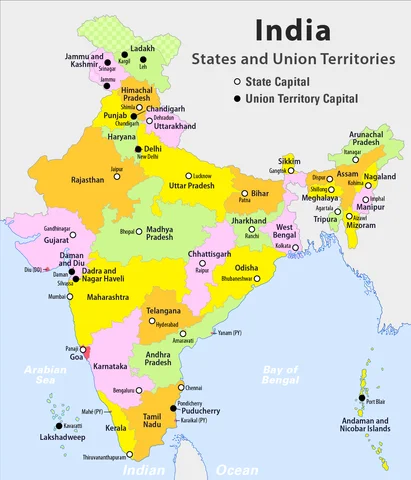Following the extensive reorganization of states in 1956, India’s political landscape continued to evolve due to popular movements and changing political circumstances. The demand for new states based on linguistic or cultural commonality led to the division of existing states.
Reorganization and Renaming States and Union Territories in Post-Independence India
Gujarat: In 1960, the bilingual state of Bombay was split into two separate states – Maharashtra for Marathi speakers and Gujarat for Gujarati speakers.
- Gujarat became the 15th state in the Indian Union.
- Dadra and Nagar Haveli: The 10th Constitutional Amendment Act of 1961 transformed Dadra and Nagar Haveli into a union territory of India.
-
- In 2020, it was merged with the union territory of Daman and Diu to create the new union territory of Dadra and Nagar Haveli and Daman and Diu, facilitated by the Dadra and Nagar Haveli and Daman and Diu (Merger of Union Territories) Act, 2019.
- Goa and Daman & Diu: were acquired from the Portuguese through a police action in 1961.
- Initially they were designated as union territory by the 12th Constitutional Amendment Act of 1962.
- In 1987, Goa was granted statehood, and Daman and Diu became a separate union territory.
- 1962: Puducherry includes the former French establishments known as Puducherry, Karaikal, Mahe, and Yanam.
- The French transferred this region to India in 1954.
- It was administered as an ‘acquired territory’ until 1962 when it was designated a union territory by the 14th Constitutional Amendment Act.
- Nagaland: In 1963, the state of Nagaland was created by separating the Naga Hills and Tuensang area from Assam to address the demands of the Naga movement.
- Before obtaining the status of the 16th state in the Indian Union, Nagaland was placed under the control of the governor of Assam in 1961.
- Punjab and Haryana: In 1966, the state of Punjab was divided to create Haryana, the 17th state, and the union territory of Chandigarh.
- This division was a response to the demand for a separate ‘Sikh Homeland‘ (Punjabi Subha).
- The Punjabi-speaking areas became the state of Punjab, the Hindi-speaking areas formed Haryana and the hill areas merged with the adjacent union territory of Himachal Pradesh.
- In 1971, the union territory of Himachal Pradesh attained the status of a state, becoming the 18th state in the Indian Union.
- Manipur, Tripura and Meghalaya: In 1972, a significant reorganization of the political map of North-East India was carried out. This resulted in Manipur and Tripura transitioning from union territories to states and Meghalaya gaining statehood.
- Additionally, the union territories of Mizoram and Arunachal Pradesh were formed out of the territories of Assam.
- Sikkim: Until 1947, Sikkim was a princely state in India ruled by a Chogyal.
- In 1974, Sikkim expressed its desire for closer association with India, leading to the enactment of the 35th Constitutional Amendment Act of 1974.
- This amendment conferred on Sikkim the status of an ‘associate state’ of the Indian Union.
- However, in a 1975 referendum, the people of Sikkim voted to abolish the institution of Chogyal and integrate Sikkim into India, resulting in the 36th Constitutional Amendment Act of 1975.
- This made Sikkim the 22nd state and amended the First and Fourth Schedules of the Constitution while introducing a new Article 371-F for special provisions related to Sikkim’s administration.
- Mizoram, Arunachal Pradesh, and Goa: In 1987, three new states, Mizoram, Arunachal Pradesh, and Goa, were established as the 23rd, 24th, and 25th states of the Indian Union, respectively.
- Mizoram, which was initially a union territory, was granted full statehood following the Mizoram Peace Accord of 1986.
- The state of Goa was created by separating it from the Union Territory of Goa, Daman and Diu.
- Chhattisgarh, Uttarakhand, and Jharkhand: In 2000, three additional states, Chhattisgarh, Uttarakhand, and Jharkhand, were carved out of the territories of Madhya Pradesh, Uttar Pradesh, and Bihar, respectively.
- These became the 26th, 27th, and 28th states of the Indian Union.
- 2014: Telangana: In 2014, the state of Telangana came into existence as the 29th state, emerging from the territories of Andhra Pradesh.
- The Andhra State Act of 1953 established the first linguistic state of India by segregating Telugu-speaking areas from the State of Madras.
- The States Reorganization Act of 1956 merged the Telugu-speaking areas of Hyderabad state with the Andhra state to create an enlarged Andhra Pradesh.
- The Andhra Pradesh Reorganisation Act of 2014 separated Andhra Pradesh into two separate states, Andhra Pradesh (residuary), and Telangana.
- Jammu & Kashmir and Ladakh: Until 2019, the former state of Jammu and Kashmir had its own constitution and enjoyed special status under Article 370 of the Indian Constitution.
- In 2019, this special status was made inoperative through a presidential order, known as “The Constitution (Application to Jammu and Kashmir) Order, 2019,” which extended all provisions of the Indian Constitution to Jammu and Kashmir.
- However, Article 370 remains in the Constitution, although inoperative.
- The Jammu and Kashmir Reorganisation Act of 2019 divided the erstwhile state into two separate union territories: Jammu & Kashmir and Ladakh.
- The union territory of Jammu and Kashmir includes all districts of the former state except “Kargil and Leh districts”, which became part of the union territory of Ladakh.
Enroll now for UPSC Online Course
| Ignite your Mind:
India has been witnessing continuous political transformation with the formation of new states after its Independence. Even after more than 70 years of Independence, the aspiration for new states is still not ended. What do you think what factors should be considered for the formation of a new state ? Mention the areas of our country from where such demand is often heard. |
Change of Names of States and Union Territories
Several States and Union territories have undergone name changes over the years.
- Uttar Pradesh: The United Provinces was renamed Uttar Pradesh‘ in 1950.
- Tamil Nadu: Madras became ‘Tamil Nadu’ in 1969.
- Karnataka and Lakshadweep: In 1973, Mysore was renamed ‘Karnataka,’ and Laccadive, Minicoy, and Amindivi Islands were renamed ‘Lakshadweep.’
- National Capital Territory of Delhi: In 1992, the Union Territory of Delhi was redesignated as the National Capital Territory of Delhi through the 69th Constitutional Amendment Act of 1991, without being granted full statehood.
- Puducherry: In 2006, Uttaranchal was renamed ‘Uttarakhand,’ and Pondicherry became ‘Puducherry.’
- Odisha: In 2011, Orissa was renamed ‘Odisha.’
- Article 3: These name changes were carried out under Article 3 of the Constitution by the Parliament.

- Laws made by Parliament under Article 3
| Serial number | Acts | Features |
| 1 | Assam (Alteration of Boundaries) Act,
1951 |
|
| 2 | Andhra State Act, 1953 |
|
| 3 | Himachal Pradesh and Bilaspur (New
State) Act, 1954 |
|
| 4 | States Reorganisation Act, 1956 |
|
| 5 | Andhra Pradesh and Madras (Alteration
of Boundaries) Act,1959 |
|
| 6 | Bombay Reorganisation Act,1960 |
|
| 7 | Acquired Territories (Merger) Act, 1960 |
|
| 8 | State of Nagaland Act, 1962 |
|
| 9 | Punjab Reorganisation Act, 1966 |
|
| 10 | Bihar and Uttar Pradesh (Alteration of
Bihar and Uttar Pradesh. Boundaries) Act, 1968 |
—- |
| 11 | Andhra Pradesh and Mysore (Transfer of Territory) Act, 1968 | —— |
| 12 | Assam Reorganisation (Meghalaya) Act,
1969 |
Meghalaya, within the State of Assam |
| 13 | North-Eastern Areas (Reorganization)
Act, 1971 |
|
| 14 | Mysore State (Alteration of Name) Act 1973 | —– |
| 15 | Laccadive, Minicoy and Amindivi Islands (Alteration of Name) Act, 1973 | —– |
| 16 | Haryana and Uttar Pradesh
(Alteration of Boundaries) Act, 1979 |
—- |
| 17 | State of Mizoram Act, 1986
State of Arunachal Pradesh Act,1986 |
|
| 18 | Goa, Daman and Diu
Reorganisation Act, 1987 |
—- |
| 19 | Madhya Pradesh Reorganisation
Act, 2000 |
—– |
| 20 | Uttar Pradesh Reorganisation
Act, 2000 Bihar Reorganisation Act, 2000 |
|
| 21 | Uttaranchal (Alteration of Name) Act,
2006 Pondicherry (Alteration of Name) Act,2006 |
|
| 22 | Orissa (Alteration of Name) Act, 2011 | — |
| 23 | Andhra Pradesh Reorganisation Act,
2014 |
|
| 24 | Jammu and Kashmir Reorganisation Act,
2019 |
|
| 25 | Dadra and Nagar Haveli and Daman
and Diu (Merger of Union Territories) Act, 2019 |
|
Enroll now for UPSC Online Course
| Must Read | |
| Current Affairs | Editorial Analysis |
| Upsc Notes | Upsc Blogs |
| NCERT Notes | Free Main Answer Writing |
Conclusion
India’s political map has been reshaped multiple times to address regional aspirations and administrative efficiency.
- These changes reflect ongoing efforts to accommodate linguistic, cultural, and historical factors, demonstrating the country’s commitment to a more representative and cohesive federation.
- Despite these adjustments, the quest for new states continues, highlighting the ever-evolving nature of India’s political landscape.
Sign up for the PWOnlyIAS Online Course by Physics Wallah and start your journey to IAS success today!
| Related Articles | |
| State Reorganization Act of 1956 | Major Constitutional Amendments: Evolution of India’s Constitution |
| Union Territories | Constitution: A Living Document |

 GS Foundation
GS Foundation Optional Course
Optional Course Combo Courses
Combo Courses Degree Program
Degree Program











